Towards the Advancement of Rotating Synthetic Aperture Space Telescope Technology
Author(s)
Kramer, Evan Laith
DownloadThesis PDF (40.87Mb)
Advisor
Masterson, Rebecca A.
Terms of use
Metadata
Show full item recordAbstract
Optical imagery of the Earth from space-based telescopes is one of the most valuable tools for understanding various large and small-scale processes. Value is derived from the unique observing perspective on orbit, which has enabled an expansive list of new science from the discovery of the ancient city of Tanis in Egypt to the creation of maps that locate invasive plant species on the Galapagos islands. Regardless of the observing target, it is desirable to obtain the highest resolution imagery possible. The traditional approach to improving image resolution is to increase the size of the optical payload’s aperture. However, larger aperture payloads become prohibitively difficult to manufacture and excessively expensive to design, build, launch, and operate. Application of rotating synthetic aperture (RSA) technology, which is a kind of dilute aperture imaging system, to space telescope designs has the potential to unlock the design space of low mass and cost, high resolution space telescopes. RSAs employ a high aspect ratio rectangular aperture that spins about the principal optical axis. A complete image is formed after a 180 degree rotation during which multiple frames are acquired to fully sample the imaging system’s optical transfer function.
While the advanced observing capabilities of RSAs hold much promise, the ability to accurately control an RSA's spinning and target tracking dynamics remains an unproven engineering challenge. To this end, the purpose of this work is twofold. First, spin rate ranges and torque requirements for RSA imaging maneuvers in various Earth orbital regimes were determined based on signal to noise ratio (SNR), look angle, ground sampling distance (GSD), field of view (FOV), and image smear. These results were used to define aspects of RSA imaging maneuver concept of operations (CONOPs) to serve as reference trajectories for future control algorithm testing. Second, characterization of the attitude determination subsystem of a larger RSA testbed, the dynamics and controls testbed (DCT), was accomplished by conducting laboratory experiments to determine noise figures and biases present in the subsystem's attitude sensors. This characterization enabled development of software-based sensor emulators to be integrated into RSA control algorithm simulations and accurate determination of estimation parameters to be implemented during RSA imaging maneuver tests on the DCT. The work presented in this thesis contributed to advancing the technology readiness level (TRL) of RSA space telescope attitude control and ultimately seeks to enable further development of this potential next generation observing platform.
Date issued
2022-05Department
Massachusetts Institute of Technology. Department of Aeronautics and AstronauticsPublisher
Massachusetts Institute of Technology